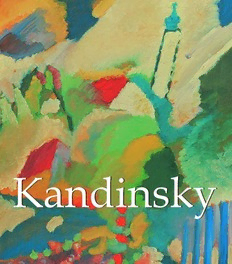
Kandinsky PDF
Preview Kandinsky
KKaannddiinnsskkyy Page 4: Kandinsky in Berlin, January 1922. Photograph. Musée national dÊArt moderne, Centre Georges-Pompidou, Paris. Layout: Baseline Co. Ltd 61A-63A Vo Van Tan Street Nam Minh Long, 4th Floor District 3, Ho Chi Minh City Vietnam © Confidential Concepts, worldwide, USA © Parkstone Press International, New York, USA Image-Barwww.image-bar.com All rights reserved. No part of this publication may be reproduced or adapted without the permission of the copyright holder, throughout the world. Unless otherwise specified, copyright on the works reproduced lies with the respective photographers, artists, heirs or estates. Despite intensive research, it has not always been possible to establish copyright ownership. Where this is the case, we would appreciate notification. ISBN: 978-1-78525-039-2 2 „Every work of art is the child of its age and, in many cases, the mother of our emotion. It follows that each period of culture produces an art of its own which can never be repeated.‰ · Wassily Kandinsky 3 Biography 16 December 1866: Wassily Wassilyevich Kandinsky is born in Moscow. His parents are Lidia Ticheeva and Wassily Silvestrovich Kandinsky. 1871: The Kandinsky family moves to Odessa where Wassily attends a classical grammar school and takes cello and piano lessons as well as drawing classes. 1886: He begins to study Law and Economics at the University of Moscow. 1892: He receives his Ph.D. and works as a teacher at the law faculty. He marries his cousin Anna Chimyakina. At this time he starts turning increasingly towards painting. 1896: He moves to Munich, at the time one of EuropeÊs art centres, to devote himself completely to art. 1897-1899: In Munich he attends the school of Anton Ažbe. 1900: Studies at the Munich Academy of Fine Arts. His teacher is Franz Stuck, then considered the best draughtsman in Germany. 1901: Kandinsky and his colleagues found the Phalanx artistsÊ group, which soon opens its own drawing school. Kandinsky later becomes the groupÊs president. During the following four years he organises exhibitions. 1902: He meets young artist Gabriele Münter, for whom he will divorce his wife in 1910. The same year he exhibits in the Berlin Secession for the first time. 1903: First solo exhibition in Moscow. 1903-1908: He and Münter undertake several journeys: Holland, Tunisia (Kairouan), France (Paris), Russia, Italy (Rapallo), Germany (Dresden and Berlin). They move into a house in Murnau, Bavaria in 1908. 1904: Two solo exhibitions in Poland. His work is shown at the Salon dÊAutomne in Paris. 1909-1910: Kandinsky founds the Munich New ArtistsÊ Association(Die Neue Künstlervereinigung München). Kandinsky spends autumn and winter of 1909 in Russia, where he exhibits fifty-two works at the „International‰ Salon in Odessa and participates in an exhibition of the Knave of Diamonds group. 5 1911: Together with Franz Marc, Kandinsky founds The Blue Rider(Der Blaue Reiter). Piper Verlag publishes KandinskyÊs first important written work, Über das Geistige in der Kunst (Concerning the Spiritual in Art), the first theoretical base for abstract art. 1914: At the outbreak of the First World War, he separates from Münter and goes back to Russia through Switzerland, Italy, and the Balkans. The coupleÊs last meeting, in Stockholm during the winter of 1915-1916, marks the end of their relationship. 1917: Kandinsky marries Nina Andreewskaya, aged 17. His political environment is shaped by the Russian Revolution. The Soviets are looking for Russian avant-garde artists. After the October Revolution, Kandinsky holds a number of different positions in the newly created Soviet cultural institutions. He is among the founders of INKhUK (Institute of Artistic Culture) and heads its monumental painting studio. 1918: He becomes a professor at the Russian Academy of Arts and writes his autobiography which is translated into Russian. 1920: He starts a professorship at Moscow University. The Soviets reorient towards Socialist Realism. 1921: Kandinsky and his wife leave Moscow for Berlin. He joins the Bauhaus in Weimar as a professor. 1923: Kandinsky has his first one-man exhibition in New York. The following year, together with his Bauhaus colleagues, Paul Klee, Lyonel Feininger, and Alexei Jawlensky, he organises the Blue Fourgroup whose lectures and exhibitions reach the United States. 1925: The Bauhaus is moved to Dessau where he teaches mural painting. 1926: His essay Point and Line to Planeis published. 1928: His production of MussorgskyÊs Pictures at an Exhibition is performed at the Friedrich Theatre in Dessau. 1933: The National Socialists close the Bauhaus. Kandinsky immigrates to Paris. 1937: Kandinsky works are defamed at the „Degenerate Art‰ propaganda exhibition. The National Socialists confiscate 57 pieces of his work. 1940: After the German invasion of France, Kandinsky flees to the Pyrenees. 13 December 1944: Kandinsky dies in Neuilly-sur-Seine, France. 7 Concentration Not long ago it seemed that the 20th century had not only begun with Kandinsky, but ended with him as well. But no matter how often his name is cited by the zealots of new and fashionable interpretations, the artist has passed into history and belongs to the past and to the future, perhaps to a greater degree than to the present. So much has been written and said about Kandinsky. His works, including his theoretical ones, are so well-known that this Mountain Lake 1899 Oil on canvas, 50 x 70 cm Manukhina Collection, Moscow 8 9 abundance of knowledge and commonplace opinions often hinders our seeing the artist in his individuality, in his real – not mythologised – significance. With a fresh gaze. From the threshold of the third millennium. Weary of arch postmodernist games, the experienced and serious viewer today seeks in Kandinsky that which no one had seen in him earlier – and had not attempted to see: a buttress in an unstable world of artistic phantoms and fashionable shams. What just less than a hundred years ago was born as a The Port of Odessa c. 1900 Oil on canvas, 65 x 45 cm The State Tretyakov Gallery, Moscow 10
